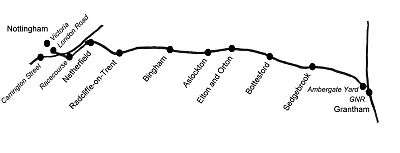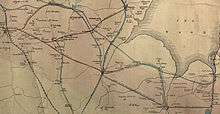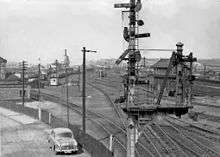Ambergate, Nottingham, Boston and Eastern Junction Railway
| Locale | England |
|---|---|
| Dates of operation | 1846–1861 |
| Stations and Landmarks |
|---|
|
Nottingham London Road High Level |
The Ambergate, Nottingham, Boston and Eastern Junction Railway was an early British railway company, which opened in 1850.
The original aim was to link to the proposed Manchester, Buxton, Matlock and Midlands Junction Railway at Ambergate to link Manchester with Boston and the East Coast. It would proceed eastwards north of Ripley and Eastwood to a proposed Midland Railway line from Bulwell to Nottingham. There it would join the latter's Lincoln line as far as Colwick where there would be a junction. Proceeding to Grantham and Spalding, there would be two branches, one to Sleaford, the other to Boston[1]
Not only were subscriptions minimal, some investors reneged on their pledges - a common state of affairs in early railway history. In the event it only opened from Nottingham to Grantham. The line is still in use.
The Ambergate, Nottingham and Boston and Eastern Junction Railway Act received Parliamentary approval on 16 July 1846,[2] and the engineer was John Underwood, an associate of John Urpeth Rastrick.[3]
For all that it crossed a number of river valleys, the terrain was favourable. The major engineering work was the viaduct at Radcliffe over the River Trent. The Trent Navigation Company insisted on a clear span of at least 100 ft and so a 110 ft cast iron arch was constructed on the northwest side, with three masonry arches on the approach.[4]

Opening
Rather than build its own expensive station in Nottingham, the ANB&EJR sought running powers into the Midland Railway's Carrington Street station, from a junction at Colwick. With the support of the city fathers it obtained these, but the Midland insisted that ANB&EJR bought out the Nottingham and Grantham Canals two months after opening the line from Ambergate to Grantham. This final blow to the company's overstretched finances were to have unfortunate, and unintended, repercussions for the Midland.
The line opened for passengers on 15 July 1850 from its own terminus at Ambergate Yard at the Old Wharf in Grantham to Colwick Junction.[1]
Initially it was worked by E. B. Wilson and Company under contract to the proprietors, with David Joy as the locomotive foreman. The opening seems to have been somewhat chaotic. We have an informative account in David Joy's diary[5] in which he tells us that, when he arrived two days before the opening, nothing was ready for him, and no engines to be found. He prevailed upon the Midland to lend him two Bury Singles.
He writes "E. B. Wilson fetched me on a Friday evening in a cab, took me to Arthington Hall to go next evening to open Nottingham and Grantham Railway on the Monday. He had taken it to work by contract at 2s. per mile run. No engines, nothing ready. To Nottingham early Saturday. Midland Railway supplied us with two old Bury's singles to be at Grantham Sunday night. Saturday afternoon over the line with Underwood (engineer), Gough (secretary), and on the contractor's (G. Wythes) engine (ballast), went off the road, not very fast, but a jolly tumble about."

However the first train departed at 9 a.m. with half a dozen second and third class carriages and a number of wagons.
As with most railways of the time, operation was somewhat haphazard and it wasn't long before the first accident in October, 1850.
Joy again: "We had got another engine from Railway Foundry, known as No. 266, and she did "goods"; and Nottingham Goose Fair coming, and a special ordered for Nottingham, I snapped at the chance of driving one of the engines. I don't know how it all came about, but at night I found myself on the leading engine, the other old Bury behind with old Pilkington as driver down at the junction of the Mansfield line at the front of a long line of carriages, on the down main line, which, for the day, was being used to stand lines of trains—the down trains for Mansfield being shunted at the junction on to the up line to the next station. It was pitch dark; and we waited for a signal to go on to Nottinghem with our train, and waited long. At last a rustle, and I thought we were going to be liberated by the passing out of the mail to Derby. So watched for her disappearing sideways to the right, but no, I could see her sweeping round and approaching us. And instantly I calculated that she could not have stopped and passed on to the up line at the junction, so must be on our line rushing upon us. It was not many seconds before we found all this true, as we jumped from our engines and rushed forward on the "in" side of the curve, and only just in time, for I saw the flare of the ashpan of the coming engine ripple over the sleepers as she came on, and heard the broken buffers of my own engine wizz over my head. It was only just in time, the next instant our two poor little light Bury engines were one wreck of material in front of the big six-coupled, with a train of twenty crammed carriages behind her. The footplate of my engine disappeared entirely, the firebox of the engine falling in between the legs of the tank—buffers and buffer beams gone altogether. It was an awful experience, and none of us forgot it in a hurry."
The Midland lent some more engines and Joy writes "one was a little Sharp. This little engine was nearly the death of a nephew of one of my directors. He wanted to ride with me on the footplate one night with a special I said, No! We ran down Bingham Bank into a fog — stuck — no weather board. Suddenly we went through the road crossing gates, the bits flew all round us, we knew how to duck."
Takeover battle
Both the Midland and the LNWR were interested in making a takeover, since it would impede the Great Northern's progress. Meanwhile, the Great Northern was keen to penetrate Nottinghamshire and its coalfields, something that Midland in particular was resisting, making a takeover offer in 1851.[6] However a member of the GNR board had acquired a holding of ANB&EJR shares and was able to resist the offer.
In 1852 the Great Northern arrived at Grantham and a connection was built into its station. Running rights were agreed such that the GN was able advertise through coaches from Nottingham to London in competition with the Midland.[7]
The latter obtained an Order in Chancery preventing the GN from running into Nottingham, but in 1852 an ANB&EJR train arrived in Nottingham with a GNR locomotive at its head. When it uncoupled and went to "run around" the train it found its way blocked by a Midland loco, while another blocked its retreat. The engine was shepherded to a nearby shed and, for good measure, the tracks were lifted. This episode became known as the "Battle of Nottingham" and, though the action moved to the courtroom, it was seven months before the loco was released.
From 2 April 1855 the Great Northern agreed to work the line for a period of ten years. The directors of the ANBEJR, not having completed the line throughout, held that they were not bound to buy the two canals. The canal proprietors took the matter to court, the sale was effected and, in 1860, the name was changed to the Nottingham and Grantham Railway and Canal Company.[8] In 1861 it was leased to the GNR completely.[1]
Though the Midland grudgingly accepted passengers into its station, it refused to handle goods which had to be carted from the terminus at Colwick.[9] The GNR therefore built its own terminus at London Road in 1857. In 1900 a new station, Nottingham Victoria, was built jointly with the Great Central Railway.

The GNR built its GNR Derbyshire and Staffordshire Extension in 1878 then acquired the Stafford and Uttoxeter Railway in 1881 thus gaining a through route from Grantham to Wales.
Present day
The line is still open to passengers (see Nottingham-Grantham Line) and the table above shows the present day stations. It departs from the Nottingham line at Colwick Junction as a double line, reducing to single immediately on the approach to Grantham station.[10]
References
- 1 2 3 District map of the Ambergate, Nottingham & Boston, and Eastern Junction Railway, with extension and branches (Map). Late 19th century. ref: 4 GL/5/6. Acc. Number: 2008/35 – via Lincolnshire Archives. Check date values in:
|date=(help) - ↑ "Ambergate, Nottingham and Boston and Eastern Junction Railway Company". The National Archives.
- ↑ "John Urpeth Rastrick, Ambergate, Nottingham, Boston and Eastern Junction Railway". Kylenano. Archived from the original on 8 February 2012.
- ↑ "Radcliffe-on-Trent Viaduct". Engineering Timelines.
- ↑ "David Joy's Diaries". SteamIndex.com.
- ↑ Fortey, Neil (16 October 2007). "Early Days on the Ambergate Railway - Extracts from a book by Robin Leleux (1984)". Bottesford Living History. Bottesford Local History Society. Archived from the original on 12 February 2012.
- ↑ Anderson, P.H. (1985). Forgotten Railways Vol 2: The East Midlands (2nd ed.). Newton Abbot: David and Charles.
- ↑ An Act for changing the Name of "The Ambergate, Nottingham and Boston and Eastern Junction Railway and Canal Company" to the Name "The Nottingham and Grantham Railway and Canal Company," and for reducing and regulating their Capital and borrowing Powers; and for other purposes. (The Nottingham and Grantham Railway and Canal Act, 1860). 23 Victoria, cap.xxxvi. Date 1860
- ↑ Kingscott, G. (2004). Lost Railways of Nottinghamshire. Newbury: Countryside Books.
- ↑ Jacobs, G., ed. (2006). Railway Track Diagrams: Book 2: Eastern:Chart 30 (3rd revision ed.). Bradford on Avon: TRACKmaps.